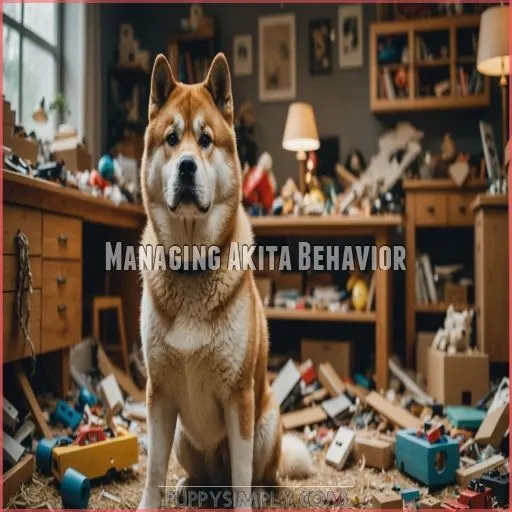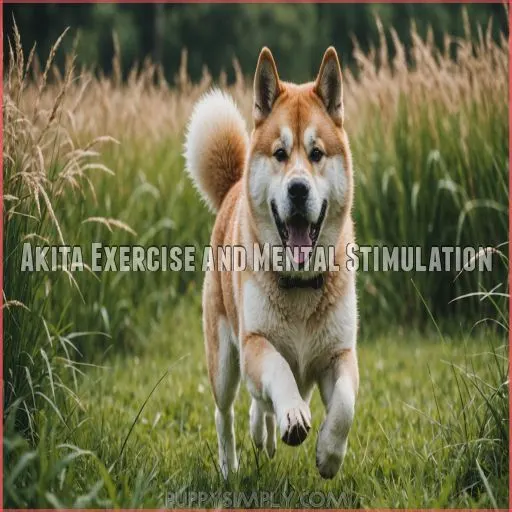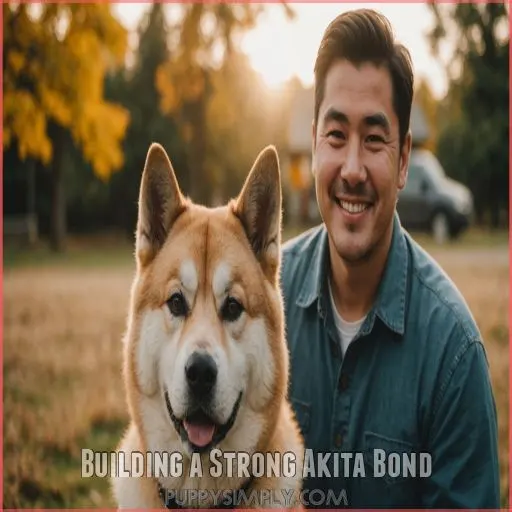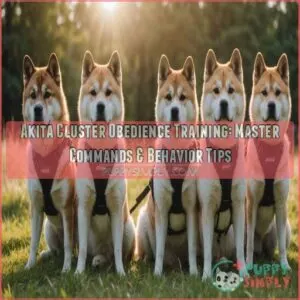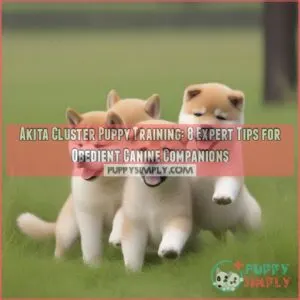This site is supported by our readers. We may earn a commission, at no cost to you, if you purchase through links.

Understand your Akita’s body language to spot aggression triggers, and use patience and consistency to address stubbornness.
Provide ample exercise and mental stimulation to keep them happy and healthy. With the right approach, you’ll transform your energetic Akita into the envy of the dog park. Stay tuned for more Akita training insights!
Table Of Contents
- Key Takeaways
- Training Akita Puppies
- Akita Training Techniques
- Managing Akita Behavior
- Akita Exercise and Mental Stimulation
- Akita Leash Training
- Akita Potty Training
- Akita Socialization
- Akita Grooming and Health
- Akita Nutrition and Diet
- Building a Strong Akita Bond
- Frequently Asked Questions (FAQs)
- Are Akita dogs easy to train?
- Do Akitas bond with one person?
- How do I stop my Akita from pulling?
- Are Akitas hard to potty train?
- What toys are best for Akita teeth?
- How to manage Akita separation anxiety?
- What motivates Akitas during training?
- How to introduce Akitas to new environments?
- What are signs of Akita trust issues?
- Conclusion
Key Takeaways
- Stay patient and consistent when training your Akita – they can be stubborn, but positive reinforcement and high-value treats will work wonders.
- Understand your Akita’s unique body language and communication style to spot potential aggression triggers and address them early on. Consistent training is key to building trust and respect.
- Keep your Akita’s mind and body active with plenty of exercise, puzzles, and interactive toys. A bored Akita can be mischievous.
- Gradually introduce your Akita to new environments and experiences, using praise and rewards to build their confidence. With time and care, you will have a well-rounded, loyal companion.
Training Akita Puppies
Training Akita puppies is an adventure that requires patience, lots of treats, and maybe a sense of humor when they test your limits like pointers can be.
Embrace their playful antics, but start early with socialization and training to turn their mischievous energy into well-mannered behavior.
Understanding Akita Puppy Growth and Development
As your Akita puppy grows, it’ll hit various milestones just like a whirlwind.
Growth charts can help track these changes.
Feeding schedules and early training adapt with their size.
Early Socialization and Training for Akitas
Proper socialization with training is key for Akita puppies, making them well-mannered.
Introduce them to various environments, people, and pets early on.
Understanding their unique Akita temperament helps with dog training challenges.
You’ll have a loyal, social companion in no time!
Managing Mischievous and Defiant Behavior in Akita Puppies
Akita puppies can be mischievous and defiant.
Don’t get discouraged! Stay patient and consistent.
Try these tips:
- Start crate training early to establish boundaries.
- Organize regular puppy playdates for socialization.
- Provide plenty of chew toys to curb destructive behaviors, like those found for teething puppies.
- Reward good behavior with praise and treats.
Teaching Acceptable and Unacceptable Behavior to Akita Puppies
Handling mischievous Akita antics requires teaching acceptable behavior—kind of like channeling their inner superhero!
Focus on early socialization and crate training, addressing puppy nipping, and reinforcing potty training.
Consistent guidance transforms chaos into calm.
Got dog training questions?
Akita futures look pawsitively promising!
Akita Training Techniques
Training your Akita doesn’t have to feel like a never-ending tug-of-war if you use positive reinforcement to make learning fun and rewarding.
With high-value treats and timely praise, you’ll soon have a furry friend ready to show off their best behavior instead of being stubborn as a mule.
Positive Reinforcement Training for Akitas
Training your Akita can feel like taming a whirlwind, but positive reinforcement works wonders.
Embrace dog training tips that focus on Akita temperament and training consistency.
Keeping a positive attitude helps tackle training challenges, reducing dog reactivity, ensuring harmonious pet relationships.
Using High-Value Treats for Akita Training
Akitas love their favorite treats! Use high-value rewards like chicken, cheese, or liver to motivate your pup during training.
A consistent treat schedule keeps your Akita engaged and keen to learn.
Get creative with healthy alternatives too.
Catching Your Akita Being Good and Rewarding Good Behavior
You’ve mastered high-value treats; now watch for your Akita’s golden moments.
Picture them sitting calmly during a squirrel fiasco—reward that behavior!
Use positive reinforcement like Akita rewards to encourage good behavior.
Your dog training program will feel like dog training success!
Avoiding Punishment and Negative Reinforcement
While training your Akita, remember that punishment can backfire faster than a boomerang.
Instead, opt for force-free training and consistency.
Positive training with alternative methods can work wonders.
Understand dog communication to tackle dog behavior problems and aggression effectively, especially when dealing with littermate syndrome.
Consistence is key!
Managing Akita Behavior
Understanding your Akita’s behavior is key to a harmonious relationship, especially since these majestic dogs can be both playful and stubborn.
By learning to read their body language and manage their occasional dominance, you’ll be well-equipped to encourage good habits and reduce those not-so-great ones.
Understanding Akita Body Language and Communication
Decoding your Akita’s silent language is key. Watch their tail, ears, and facial expressions – these reveal their inner state. Tune in to their body cues, and you’ll understand what they’re trying to tell you.
- Akita tail signals: Wagging high and stiff = confidence, low and tucked = fear
- Akita ear positions: Perked up = alert, flattened back = aggression
- Akita vocalizations: Soft whines = contentment, deep growls = warning
Recognizing and Managing Aggression in Akitas
Recognizing aggression triggers is like finding a needle in a haystack, but early intervention is key.
Keep an eye on dog-dog aggression, resource guarding, and signs of a reactive dog.
For dog training help, work on bite prevention and behavior modification.
Dealing With Stubbornness and Dominance in Akitas
Just as you manage aggression, tackling stubbornness in Akitas involves patience and clever dog training tips. Think of Akita leadership like being a steadfast captain steering a ship through pack dynamics.
- Stay consistent and firm.
- Use positive reinforcement.
- Employ clear, firm commands.
- Embrace their unique dog personality.
Encouraging Good Behavior and Reducing Undesirable Behaviors
After tackling Akita dominance, let’s encourage good behavior. Act like a dog behavior expert and reward positive actions.
Akitas respond well to praise and treats.
Socialization helps curb Akita aggression.
Humor them, and remember: patience is key in Akita training.
Akita Exercise and Mental Stimulation
Akitas may be regal and dignified, but they’re still energetic pups that need plenty of exercise and mental stimulation.
From engaging puzzles to safe playtime, discover how to keep your Akita happy, healthy, and well-behaved.
Providing Adequate Physical Exercise for Akitas
Managing Akita behavior involves catering to their exercise needs.
Daily walks and safe play activities are important.
Think of it like toddler energy gone canine!
Make sure exercise is age-appropriate; you don’t want little Hercules straining muscles.
Happy dogs lead to happier owners.
Engaging Akitas’ Minds With Puzzles and Interactive Toys
Keeping an Akita’s mind sharp is as essential as a brisk walk. Use toys and puzzles to beat boredom and boost their doggy smarts.
- Rotate puzzles frequently
- Make sure toys are safe
- Sprinkle with high-value treats
- Challenge their intelligence
Mental stimulation is key to a happy and healthy Akita.
Choosing Safe Activities for Growing Akita Puppies
Growing Akita puppies are like energetic toddlers.
Puppy-safe parks offer a playground for socialization and safe exercise.
Use chew toys to satisfy their curious teeth.
| Activity | Purpose |
|---|---|
| Puppy Parks | Socialization |
| Playtime | Exercise Types |
| Chew Toys | Safe Play |
Explore and enjoy!
Ensuring Akitas Get Enough Sleep and Rest
Ensuring your Akita gets ample shut-eye is a must – these pups need their beauty sleep!
Establish a consistent nap schedule and create a cozy, distraction-free snooze zone.
Sweet dreams lead to sweet behavior, so let your Akita catch those all-important Zs.
Akita Leash Training
Ready to tame the tugging Akita on your daily walks?
Leash training your spirited pup can be a tug-of-war,
but with a little patience and the right techniques, you’ll both be strutting like pros in no time!
Stopping Your Akita From Pulling on the Leash
When your Akita pulls like a runaway freight train, it’s time to explore pulling prevention.
Consider using a gentle leader or harness training to reduce leash pressure and tap into their unique canine communication skills, transforming walks into a dog-dog play adventure.
Teaching Your Akita to Walk on a Loose Leash
Imagine this: you’re strolling with your Akita, and it’s not tug-of-war time.
Teaching loose leash walking requires patience and consistency.
Use positive reinforcement.
Reward when they’re under threshold.
With Akita temperament, mastering this skill will make walks feel like a breeze!
Managing Reactivity and Pulling in Akitas
Dealing with your Akita’s reactivity and pulling on the leash requires patience and consistency. Try these tips:
- Identify triggers that cause your Akita to react
- Slowly desensitize your pup to these triggers using positive reinforcement
- Use a front-clipping harness or head halter to better manage pulling
- Remain calm and upbeat – your Akita feeds off your energy.
Gradually Increasing Leash Training Distances
Boost your Akita’s leash skills by gradually increasing distances.
Start small, just like baby steps, then extend their reach.
Reward progress with treats and praise.
Handle distractions with patience.
Make sure your Akita has a safe environment for their leash training progression.
| Distance | Milestones | Rewards |
|---|---|---|
| Short | Focused attention | Treats |
| Medium | Reduced pulling | Praise |
| Long | Staying calm | Extra play time |
| Extended | Handling distractions | Special treats |
Akita Potty Training
Potty training your Akita is really important, unless you want your fluffy friend thinking your living room is their personal restroom.
With a bit of humor and lots of patience, you’ll guide your pup to perfect potty manners, ensuring a happy and clean home for everyone.
Establishing a Potty Training Schedule for Akitas
After mastering leash training, it’s time for Akita potty training.
Establish a consistent schedule to avoid accidents and setbacks:
- Morning first thing
- After meals
- When waking from naps
- Before bedtime
- Regularly throughout the day
Stick to it—you’ve got this!
Choosing the Right Potty Training Location
Where should you set up your Akita’s potty spot? Consider a quiet, safe area with enough space for your pup to move around comfortably. Opt for a spot sheltered from the elements – your Akita will appreciate it!
| Ideal Potty Spot | Dog Safety | Yard Size | Weather Impact |
|---|---|---|---|
| Quiet, private | No hazards | Ample room | Shelter needed |
Dealing With Accidents and Setbacks in Potty Training
If your Akita has an accident, don’t sweat it—setbacks happen! Clean up thoroughly to prevent repeat performances.
Avoid scolding; instead, focus on gentle guidance.
Consistency is key, so maintain a steady potty schedule.
Rewarding Good Potty Behavior and Encouraging Consistency
You’re the pilot guiding your Akita to potty success!
Stick to a consistent potty training schedule, and when there’s a success, reward with treats like tiny treats.
Positive reinforcement works wonders.
Akita Socialization
Socializing your Akita is like introducing them to a world beyond their own little kingdom—it’s essential for raising a well-rounded and happy dog.
With a bit of patience and the right approach, you’ll help them make friends and discover new adventures without turning every dog park visit into a dramatic showdown.
Socializing Your Akita With People and Other Dogs
Socializing your Akita is key – from puppy playdates to dog park outings, introduce them gradually to new people and pups.
Follow proper etiquette, and make it a positive, fear-free experience.
Your Akita will thrive with careful, consistent socialization.
Managing Fear and Aggression in Akitas
Dealing with fear in Akitas is like unraveling a mystery.
Start by identifying fear triggers and understanding aggression causes to find calming techniques that work.
Implement socialization strategies using positive reinforcement to build trust and confidence.
- Seek professional help if needed
- Reward calm behavior
- Be patient and consistent
Gradually Increasing Socialization Distances and Intensity
When tackling fear and aggression, remember that safe socialization for Akitas is key.
Gradually increase distances and intensity of encounters.
Picture it like a video game: you reach new levels as Akitas grow comfortable.
Here’s a quick socialization guide:
| Situation | Distance | Duration | Intensity |
|---|---|---|---|
| Quiet park walk | Far | Short | Low |
| Busy street stroll | Medium | Medium | Medium |
| Dog-friendly cafe | Close | Long | High |
| Dog playdate | Very close | Short | High |
Encouraging Confidence and Calmness in Akitas
Building confidence in your Akita? It’s like teaching a squirrel to ride a unicycle. Patience, my friend! Use these techniques:
- Offer chew toys
- Practice gentle petting
- Use positive reinforcement
- Create calm environments
- Gradually introduce new experiences
Akita Grooming and Health
Akitas may be regal and dignified, but their grooming needs are anything but low-maintenance.
Get ready to embrace the fluffy side of your Akita as you navigate their heavy shedding and regular brushing requirements.
Staying on top of your Akita’s health and dental care is also essential for keeping your furry friend happy and healthy.
Managing Akita Shedding and Coat Blowing
Shedding season for Akitas is like a hair tornado!
Equip yourself with the right grooming tools to tame their coat blowing.
Use specific brush types to manage Akita shedding effectively and prevent hair from taking over your home.
Providing Regular Brushing and Grooming for Akitas
Managing Akita shedding means regular brushing and grooming. It’s like a spa day with Akita coat care.
Keep your puppy’s shedding management in tip-top shape with these tips:
- Choose the right grooming tools
- Brush frequently
- Plan a bath schedule
- Use dog-friendly shampoos
- Keep sessions short and sweet
Recognizing Common Akita Health Issues
Akitas are prone to common health issues like hip dysplasia and bloat, so keep an eye out!
Allergies, eye conditions, and skin problems can also be the culprits.
If your Akita’s acting off, it might be time for a vet visit.
Maintaining Akita Dental Health and Hygiene
Keeping your Akita’s pearly whites in tip-top shape is a breeze!
Brush those canines regularly with a soft-bristle toothbrush and dog-safe toothpaste.
Dental treats and chews also work wonders, helping scrub away plaque and maintain gum health.
Your Akita will thank you with a million-dollar smile!
Akita Nutrition and Diet
Feeding your Akita a nutritious diet is really important for their health and happiness, so you’ll want to choose the right food and watch their weight like you’d guard the last slice of pizza.
Plus, keeping them hydrated and aware of potential food allergies will prevent your stubborn companion from turning mealtime into a soap opera drama!
Choosing the Right Food for Your Akita
Choosing your Akita’s chow is like finding the golden snitch in a Quidditch match—it’s important yet exciting!
Consider nutritional needs, delicious homemade food recipes, and reputable commercial food brands.
Don’t overlook the raw diet benefits amid potential food allergies.
Bon appétit, pup!
Managing Akita Weight and Preventing Obesity
Think of your Akita’s diet as puzzle pieces fitting together for weight management.
Balance meals with healthy treats while avoiding oversized portions.
Combine an exercise routine for a happy, healthy Akita.
Keep things in check, like fitting into your favorite jeans!
Providing Regular Fresh Water and Hydration
Don’t forget to keep your Akita’s water bowl filled with fresh, clean water at all times.
Akitas need ample hydration to stay healthy and happy.
Watch for signs of dehydration like lethargy or dry gums.
Refill that bowl regularly!
Avoiding Common Akita Food Allergies and Sensitivities
Your Akita’s diet shouldn’t read like a mystery novel.
Check the ingredient list for common allergies like wheat or soy.
Opt for hypoallergenic options if needed.
Building a Strong Akita Bond
Building a strong bond with your Akita involves patience, trust, and a lot of furry kisses.
Establishing Trust and Respect With Your Akita
Building trust with your Akita requires understanding their subtle body language and Akita communication style.
Set consistent rules and use positive reinforcement to guide behavior.
Patience and understanding go a long way—after all, Rome wasn’t built in a day, and neither are bonds!
Encouraging Loyalty and Affection in Akitas
Cultivate an Akita’s loyalty by showering them with affection and praise.
Consistent, positive training from an early age builds the trust and respect that foster a lifelong bond.
Your Akita will adore you for being their calm, confident leader.
Managing Separation Anxiety and Distress in Akitas
Leaving home can trigger anxiety in Akitas.
Gradually desensitize them with brief absences.
Use Akita crate training alongside calming techniques to ease stress.
Address triggers patiently; consistency transforms distance distress into confidence over time.
Strengthening the Human-Akita Bond Through Training and Interaction
As handling separation anxiety strengthens, so does the bond with your Akita.
Build trust through consistent training and playful interactions.
Understand Akita communication as your secret handshake, turning challenges into teamwork.
Get to know their world; don’t just be a boss, be a buddy.
Frequently Asked Questions (FAQs)
Are Akita dogs easy to train?
While Akitas are smart cookies, their stubborn streak can make training a bit like herding cats.
Stay patient, use high-value treats, and keep sessions fun and constructive.
With persistence, you’ll raise a dignified and loyal companion.
Do Akitas bond with one person?
Akitas tend to bond strongly with one person, becoming fiercely loyal and protective.
Think of them as having a "best friend for life" mentality.
However, with proper socialization, they can be affectionate with other family members too.
How do I stop my Akita from pulling?
A stitch in time saves nine – Nip that pulling habit in the bud with consistent training.
Use a front-clip harness, reward-based methods, and patience.
You’ve got this – your Akita will walk by your side in no time!
Are Akitas hard to potty train?
Potty training your Akita can be a bit like teaching a cat to fetch, but don’t worry!
Stay consistent, use crate training, and remember patience is key.
Celebrate small victories, and you’ll see progress in no time.
What toys are best for Akita teeth?
Ah, the noble Akita—connoisseurs of their own dental hygiene!
Durable rubber toys, rope toys, or tough chew bones are great options.
They’ll keep your pup’s chompers busy while avoiding your furniture becoming an unintentional chew toy buffet.
How to manage Akita separation anxiety?
Ease your Akita’s separation anxiety by gradually increasing alone time, offering engaging toys, and maintaining a consistent routine.
A tired dog is a happy dog.
Keep their mind busy, maybe with a puzzle toy—a dog’s version of Sudoku!
What motivates Akitas during training?
Akitas are like curious cats – they’re driven by rewards that appeal to their senses.
Tempt their taste buds with mouthwatering treats, and you’ll have their undivided attention during training.
Stay upbeat, and they’ll be putty in your hands.
How to introduce Akitas to new environments?
Introduce your Akita to new environments gradually, like tiptoeing into cold water.
Start with quiet areas, praising calm behavior with high-value treats.
Keep interactions positive, turning each new setting into a delightful treasure hunt for your curious pup!
What are signs of Akita trust issues?
Jumpin’ Jehoshaphat!" When your Akita is skittish around familiar faces, unpredictably aggressive, or shows excessive guarding tendencies, you’re seeing trust issues.
Building confidence through consistent routines and positive reinforcement gets you both back on track.
Conclusion
Did you know that Akitas can weigh up to 130 pounds? That’s like owning a mini bear! Keeping your Akita in tip-top shape takes more than just size; it requires patience, consistency, and love.
With these Akita cluster dog training tips, you’ll feel empowered to raise a well-mannered companion.



